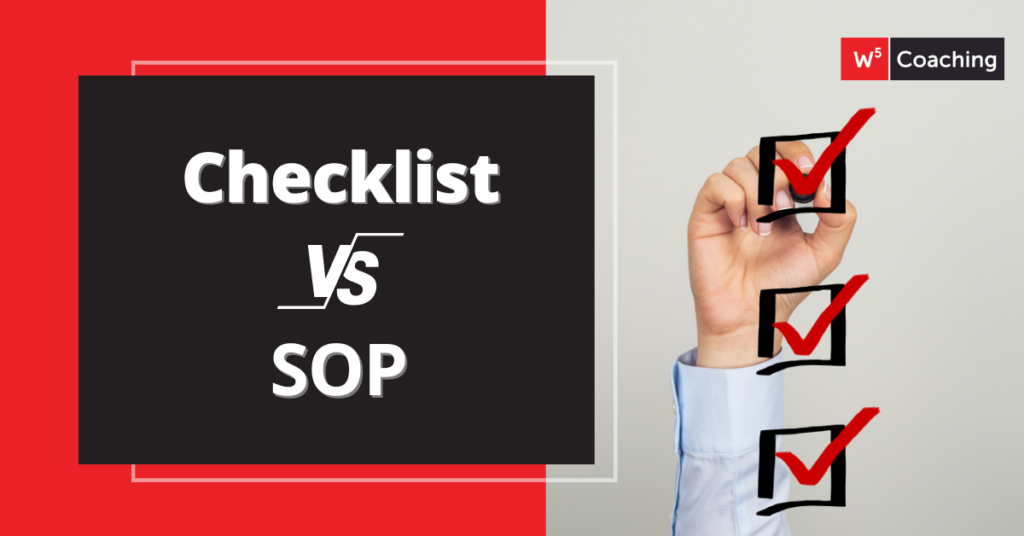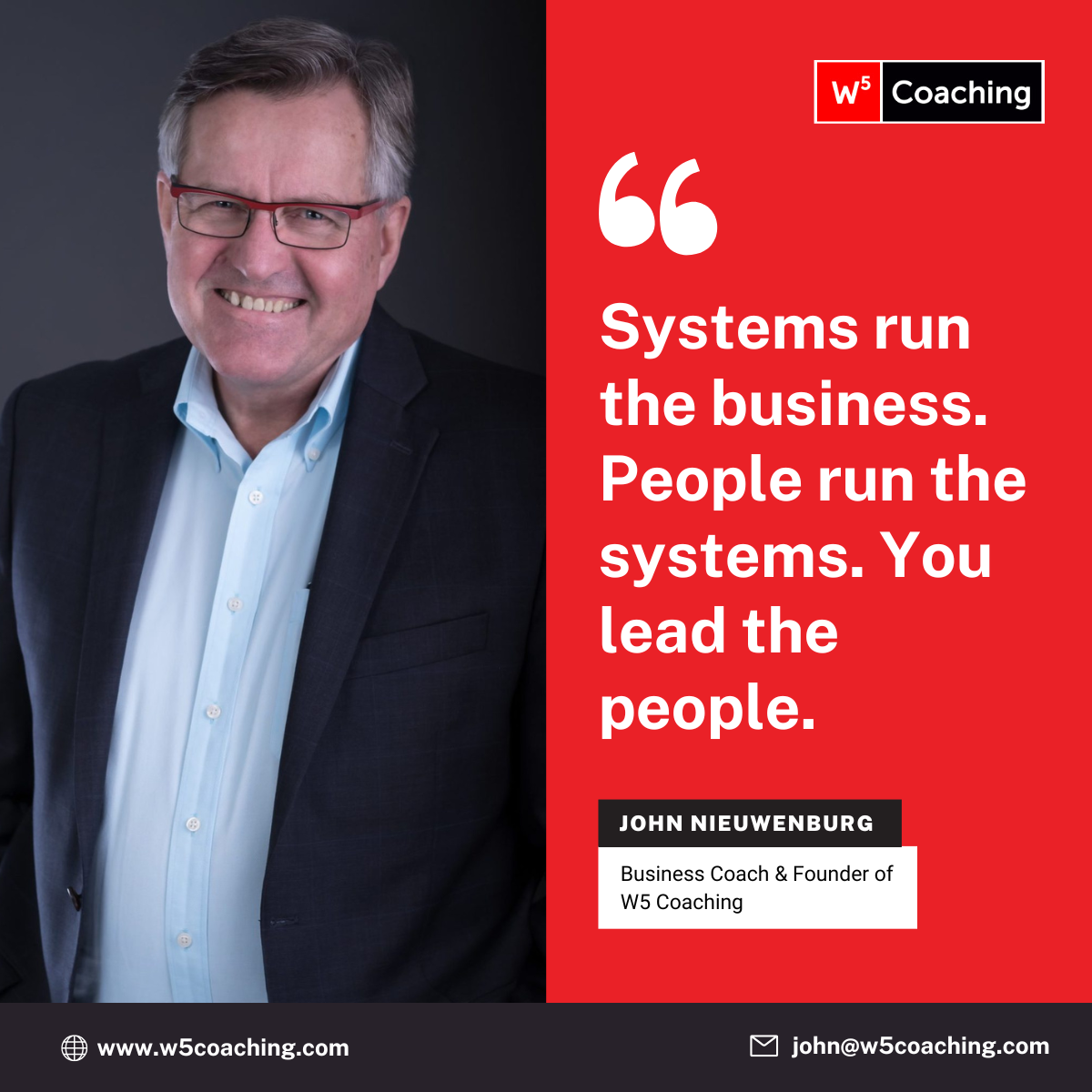Using Checklists and SOPs to Develop Systems for Your Business

Your business needs systems
If you want to have a business that runs smoothly, profitably, and mostly without you – you need systems.
At W5 we say that systems run the business, people run the systems, and you lead the people.
When you have good systems, you get:
 Improved Efficiency & Consistency
Improved Efficiency & Consistency
Well-designed systems automate repetitive tasks and streamline complex processes, reducing the time and effort required to complete them.
They also ensure that tasks are done the same way each time, leading to predictability and consistency in the quality of products and services.
Faster Training & Onboarding
Clear, well-documented systems make it easier to train new employees and get them up to speed quickly.
Systems also capture and preserve organizational knowledge, ensuring it’s not lost when an employee leaves or changes roles.
Reduced Costs & Improved Customer Satisfaction
By improving efficiency and reducing errors, implementing systems can lead to significant cost savings.
With systems in place, businesses can provide reliable, consistent service, improving customer satisfaction and loyalty.
McDonald’s is a great example of a company that leverages systems to create speedy consistency.
Time Freedom & the Ability to Scale
When you have good systems in place, your business can run (mostly) without you.
One of my clients implemented systems for *everything* in her business and freed up over 90% of her time.
Systems also allow businesses to handle increased workload or expansion more easily, as processes can be replicated and scaled up without a proportional increase in resources or complexity.
In other words, systems make it possible to scale your business.
How to build systems: create SOPs and Checklists
Checklists and Standard Operating Procedures (SOPs) are the building blocks of business systems.
Both help to ensure that operations run smoothly and efficiently, and they serve complementary but distinct purposes.
Checklist
A checklist is a list of items you need to verify, check, or inspect.
The purpose of a checklist is to ensure that all necessary steps or tasks in a process are completed.
It’s typically used as a reminder for mandatory steps and to avoid errors or omissions.
Checklists generally do not contain a lot of detail. They work best when the person using them is already trained and skilled at their job.
For example, pilots use a checklist to make sure that their airplane is ready to safely take off.
The checklist doesn’t include instructions for “how to fly the plane” and if you didn’t know how to fly a plane, you likely wouldn’t understand what the items on the checklist referred to.
This video has a great explanation of how to build good checklists:
Standard Operating Procedure (SOP)
An SOP is a detailed, step-by-step set of instructions designed to carry out a routine operation.
SOPs are generally more comprehensive than checklists.
They not only list the tasks that need to be done, but also describe how each task should be performed.
They are typically used for training purposes and to ensure that operations are carried out consistently and efficiently across different shifts, teams, or locations.
For example, McDonald’s uses SOPs to ensure that their french fries are cooked in exactly the same way in every location across the world.
The instructions are clear enough and detailed enough that a teenager in their first job can follow them.
Here’s an article to help you develop SOPs: SOPs made easy.
When do you use a checklist and when do you use an SOP?
Checklists work best when the person using it already has experience and is capable of performing the task.
The checklist acts as a reminder not to miss any steps – especially steps related to safety.
For example, even an experienced electrician can benefit from a reminder to make sure the power is turned off before performing any work that could electrocute them.
Checklists like these work even better when you employ the accountability of a buddy system: one person calls out the item on the checklist and the other confirms that it has been completed.
SOPs, on the other hand, are a better choice when:
- You need detailed “how to” instructions to help train new staff – or to serve as a reminder for staff who haven’t performed a function recently.
- You want everybody to perform a task or procedure in the exact same way for consistency.
- You want to capture and document knowledge that currently exists only in a long term employee’s head. (Often the owner!)
SOPs aren’t very useful in situations that are very complicated, complex, or require experience and judgment on the part of the person performing the work.
For example, you would have a hard time developing an SOP for heart surgery, but you could have an SOP for setting up the operating room, and a checklist to make sure all the equipment is in place and you’re operating on the right patient!
Take your business to the next level by implementing checklists and SOPs
Checklists and Standard Operating Procedures (SOPs) can really make a big difference in how your business runs.
With good systems in place, your team can be trained faster and make fewer mistakes. Systems ensure that everyone is doing their job the same way every time, which means your customers always get the same great service.
Developing systems is a worthwhile investment that will pay dividends in the long run – allowing your business to grow or scale – while increasing time freedom for the owner.
If you’d like some support to implement systems in your business, book a free call to discuss business coaching: book a call with John.

Build a Self-Managing Company
How to build a business that runs smoothly, profitably, and (mostly) without you.
Feeling stressed out and overwhelmed with a business that is taking all your time - and not giving you enough in return?
Are you finding it challenging to hire the right team (and get them to do the right things)?
I wrote this little guide for you!
Enter your details below to receive your free copy!
